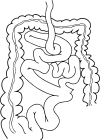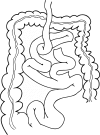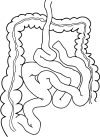Modification of internal hernia classification system after laparoscopic Roux-en-Y bariatric surgery
- PMID: 26240619
- PMCID: PMC4520845
- DOI: 10.5114/wiitm.2015.52160
Modification of internal hernia classification system after laparoscopic Roux-en-Y bariatric surgery
Abstract
Introduction: The occurrence of internal hernia is not an uncommon late complication following the laparoscopic bariatric Roux-en-Y gastric bypass procedure. In some instances, it can be life threatening if not treated in a timely manner. Although there are numerous publications in the literature addressing internal hernia, they are mostly retrospective, and focus mainly on describing the different reconstructive orientation as far as the bowel is concerned.
Aim: Our study aim is to address the relationship between the three basic elements of internal hernia, namely: intestinal mesentery defect, the involved intestine and herniated loop direction. Although a developed and widely accepted classification system of internal hernia has not been established yet, we hope this study can help the system to be established.
Material and methods: We studied all patients who underwent revision bariatric operations in the Freiburg and Lübeck University Hospitals (2007-2013). A single surgeon performed and documented all revision procedures for internal hernia. The post-operative follow-up period is up to 6 years. All patients with internal hernias were included whether their primary surgery was performed in our center or performed in other institutions, being referred to our center for further management. The presence of hernia defect, the type of herniated intestinal loop and the direction by which the herniated intestinal loop migrated were analyzed.
Results: Twenty-five patients with internal hernia were identified; in 2 patients more than one hernia type coexisted. The most frequent constellation of internal hernias was BP limb herniation into the Brolin space and migrating from left to right direction (28%). The highest incidence of internal hernia was found to be following Roux-en-Y gastric bypass (68%); the biliopancreatic limb (BP) limb was the most commonly involved intestine (51.9%). The incidence of Petersen hernia was the highest (59.3%), and left-right direction was more common. The most common hernia direction of the biliopancreatic limb was from left to right (92.6%), but alimentary limb (AL; 57.1%) and common channel (CC; 66.7%) often favor the other course.
Conclusions: There are existing different types of internal hernias after bariatric operations including separate mesenterial spaces, various intestine parts and herniation direction. Our SDL classification system may offer a useful pathway that facilitates the understanding, and systematic approach to internal hernia, which can be used by bariatric quality registers.
Keywords: Brolin space; Petersen space; bariatric surgery; internal hernia; internal hernia classification system.
Figures
References
-
- Petersen W. [Ueberdarmveschlingung nach der gastro-enterostomie] Arch Klin Chir. 1900;62:94–114.
-
- Podnos YD, Jimenez JC, Wilson SE, et al. Complication after laparoscopic gastric bypass: a review of 3464 case. Arch Surg. 2003;138:957–61. - PubMed
-
- Steele KE, Prokopowicz GP, Magnuson T, et al. Laparoscopic antecolic Roux-en-Y gastric bypass with closure of internal defects leads to fewer internal hernias than the retrocolic approach. Surg Endosc. 2008;22:2056–61. - PubMed
-
- Garza E, Jr, Kuhn J, Arnold D, et al. Internal hernias after laparoscopic Roux-en-Y gastric bypass. Am J Surg. 2004;188:796–800. - PubMed
LinkOut - more resources
Full Text Sources
Other Literature Sources
Research Materials




